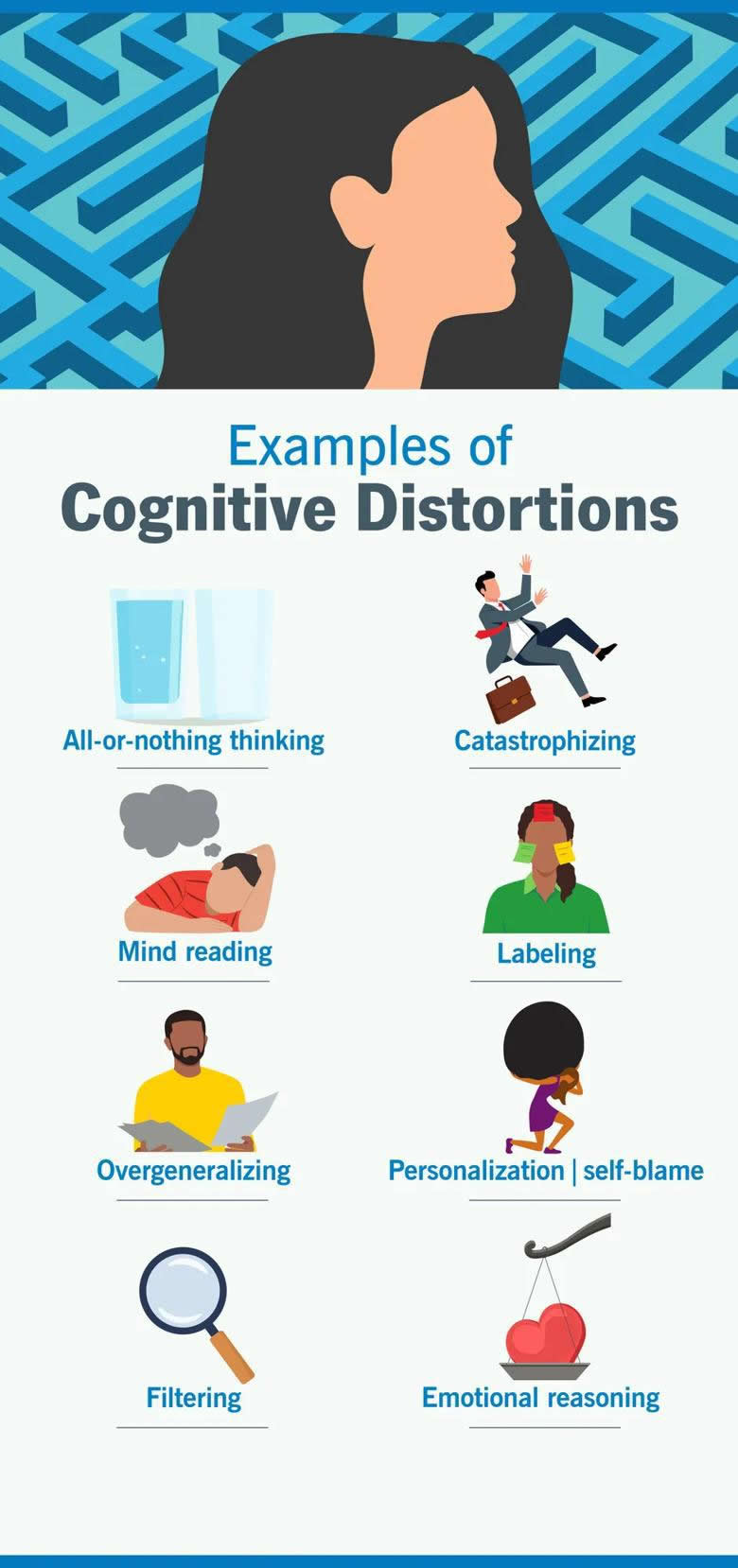What Are Cognitive Distortions? And How To Change Distorted Thinking
Cognitive distortions are ‘thought traps’ that keep you from objectively interpreting your thoughts

Our thoughts and experiences are intricately connected.
How you interpret a situation can have a big impact on how you feel about it and how you react. So much so that your thoughts can keep you from fully enjoying your successes or appreciating the positives in life.
That’s why understanding cognitive distortions is so important: Our thoughts affect how we experience life.
Sound a little abstract? Not to worry. Psychologist Susan Albers, PsyD, shares examples and advice for how to break the cycle of negative thinking.
What are cognitive distortions?

Cognitive distortions, also called distorted thinking, are “automatic, negative patterns of thinking that distort reality. They’re stories that we tell ourselves that aren’t fully true or helpful,” Dr. Albers describes.
Think of it like this: Cognitive distortions are like viewing reality through a funhouse mirror. When you engage in thought distortion, your view of the world gets bent out of shape. It can make things bigger, scarier or more intense than they really are.
In short, it can help to think of them as “thought traps,” as Dr. Albers puts it.
Examples of cognitive distortions
There are a number of ways that we engage in distorted thinking. And often, it’s so automatic that we don’t realize we’re doing it.
Dr. Albers shares a few examples of the ways negative thoughts muddy our experiences:
- All-or-nothing thinking: Assuming one failure or mistake is the end of things. “I didn’t go to the gym yesterday. I may as well cancel my membership because I clearly can’t be counted on to use it.”
- Catastrophizing: You assume the worst-case scenario will happen, even if it’s unlikely. “I can’t drive in the rain because I’ll get in an accident and probably die.”
- Mind reading: Believing you know what others are thinking and jumping to conclusions based on that. “She didn’t text me back. She must be planning to break up with me.”
- Labeling: Using one example as reason to assume a negative identity. “I forgot to call them back. I’m a terrible friend!”
- Overgeneralizing: Taking one event and applying it broadly. “Of course I didn’t get the promotion. I never do and never will.”
- Personalization/self-blame: Assuming events are directly about (or because of) you. “My team lost the game because I messed up that one play.”
- Filtering: Focusing only on the negative aspects of a situation. “The presentation was a mess because the picture on that one slide was out of focus.”
- Emotional reasoning: Assuming that because you feel something, it must be true. “I feel anxious, so something must be wrong.”
Distorted thinking doesn’t happen in a vacuum. You can experience multiple kinds of cognitive distortions in a single stream of consciousness.
- My partner is mad. (Mind reading)
- I must have done something to upset them. (Personalization/self-blame)
- I’m unlovable. (Labeling)
- They’re going to leave me and I’m going to die alone. (Catastrophizing)
What causes cognitive distortions?
We all engage in cognitive distortions to some extent. But they tend to grow and fester more if you’re living with:
- An anxiety disorder
- Depression
- Obsessive-compulsive disorder
- Unresolved trauma
“Your state of mind can heighten the tendency to engage in cognitive distortions,” Dr. Albers notes.
Engaging in distorted thinking on repeat can drag you down. The more you do it, the harder it can be to realize you’re doing it. And over time, these thought distortions can lead to increased anxiety, stress, relationship issues, confidence loss and more.
How to address cognitive distortions
It’s not always easy to notice when you’re engaging in distorted thinking, which can make changing your thought patterns tricky. But there are some ways to sort out negative self-talk and disrupt cognitive distortion.
Dr. Albers offers these steps:
1. Catch them early
“One of the things I tell my clients is, a thought is not a fact,” Dr. Albers shares. “We can take our thoughts and really challenge them.”
Thoughts that go unchallenged can snowball, creating a scenario where the problems you’re facing become something much larger and more unwieldy.
Suddenly, instead of coping with a measly 4 out of 5 on your performance review, your mind has you believing that you need to go back to school and switch to a new career field before you get fired and have to move in with your in-laws.
“If you catch them at the moment they are occurring, they don’t have time to grow into something much greater,” she continues. “The moment you notice that a cognitive distortion is happening, label it, without judgment, and ask yourself some questions. Be curious and not critical of where these thoughts come from.”
2. Identify trigger words
How can you know if your thoughts are spiraling toward the negative? Look for red-flag words like:
- Always/never
- Everyone/no one
- Nothing/everything
- Forever
- Failure
3. Keep a journal
It can be tough to follow your own train of thought in your head. That’s why Dr. Albers suggests writing down your thoughts to help capture where they’re heading.
“Journaling can give you space to challenge those disruptive thoughts,” she points out. “When you see them laid out in front of you, it’s easier to find those keywords, see what’s happening and question your inner monologue.”
When you see it in front of you in black and white, it can be easier to see if your thoughts are consistent with a cognitive distortion. You can spot the flaws in your logic, and name them according to the type of distorted thinking you’re engaging in. (Is my teen child really heading toward a career as a master criminal? Or am I overgeneralizing?)
4. Talk it out
If you’re questioning whether you’re engaging in cognitive distortion, it can help to look through someone else’s eyes.
“Ask yourself, if my friend were telling me this, would I be seeing it in a different way?” Dr. Albers suggests.
In other words, try a little role-playing. Say it out loud even. And really listen to what you’re saying — as if you were listening to a friend sharing their experience.
Would you agree they’re being rational? Would you point out faults in their logic? What would you say back to them?
5. Get support
If you’re feeling stuck in a cycle of negative thinking, there are resources that can help.
“Talking with a therapist is one of the best ways to work toward undoing cognitive distortions,” Dr. Albers advises. “There are also a lot of self-help books if you want to try working on it on your own.”
Cognitive behavioral therapy (CBT) can help you identify problematic thought patterns and how they affect you.
No matter where you turn for help, know that you’re doing yourself a favor.
“When you start to notice your own cognitive distortions, it can help your mental health overall,” Dr. Albers reinforces. “It can help you feel less anxious, feel less gloomy. And you can start to hear when other people are engaging in cognitive distortions as well. When you’re more mindful of yourself, you can become better attuned to others as well.”